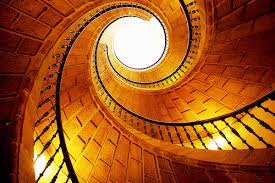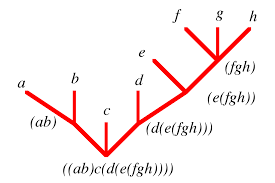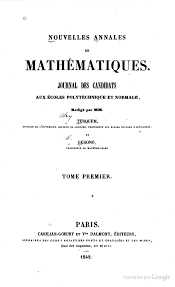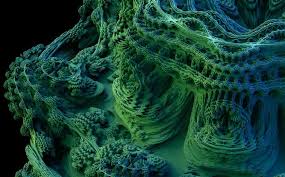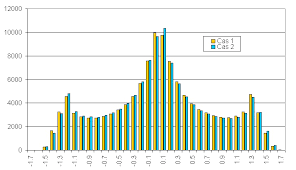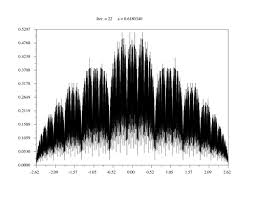06/01/2013
LIVRE Hohere Algebra. Manuscript transcription of Konigsberger's lectures. Konigsberger, Leo.
12:00 Publié dans Leo Konigsberger | Lien permanent | Commentaires (0) |  |
|  del.icio.us |
del.icio.us |  |
|  Digg |
Digg | ![]() Facebook
Facebook
Ephemera] Box containing 94 unusual illustrated arithmetic cards
11:55 | Lien permanent | Commentaires (0) |  |
|  del.icio.us |
del.icio.us |  |
|  Digg |
Digg | ![]() Facebook
Facebook
LIVRE : Theory of Games and Economic Behavior. VON NEUMANN, John. & Oskar MORGENSTERN.
11:51 Publié dans John VON NEUMANN, Oskar MORGENSTERN | Lien permanent | Commentaires (0) |  |
|  del.icio.us |
del.icio.us |  |
|  Digg |
Digg | ![]() Facebook
Facebook
LIVRE : Mathematicae Collectiones. PAPPUS, of Alexandria.
11:48 Publié dans Pappus | Lien permanent | Commentaires (0) |  |
|  del.icio.us |
del.icio.us |  |
|  Digg |
Digg | ![]() Facebook
Facebook
LIVRE Cogitata Physico Mathematica. In quibus tam naturae quàm artis effectus admirandi certissimis demonstrationibus explicantur. MERSENNE, Marin.
11:45 | Lien permanent | Commentaires (0) |  |
|  del.icio.us |
del.icio.us |  |
|  Digg |
Digg | ![]() Facebook
Facebook
Elementa Geometriae EUCLIDES.
11:43 | Lien permanent | Commentaires (0) |  |
|  del.icio.us |
del.icio.us |  |
|  Digg |
Digg | ![]() Facebook
Facebook
12 février 2013 de 15h45 à 17h00 Le génie mathématique, du théorème de quatre couleurs à la classification des groupes ENS Cachan Antenne Bretagne
Le génie mathématique, du théorème de quatre couleurs à la classification des groupes
le 12 février 2013
de 15h45 à 17h00
Conférence de Georges Gonthier (Microsoft Research, Cambridge). Départements de mathématiques et d'informatique (Ker Lann), Formation à la recherche.
Biographie: Georges Gonthier est chercheur au laboratoire de Cambridge de Microsoft Research, après avoir été à Inria et aux Bell Labs. Ses travaux vont des systèmes embarqués (langage Estérel, fusée Ariane) aux modèles de la concurrence et de la sécurité (Join-Calcul). Après avoir formalisé la preuve du théorème des quatre couleurs en 2005, il a créé l'équipe du laboratoire Microsoft Research - Inria qui vient de compléter la formalisation du théorème de Feit-Thompson. Il a reçu en 2011 le Grand Prix d'informatique de la Fondation EADS.
Note: Conférence organisée conjointement avec le département d'informatique.
- Type :
- Séminaires - conférences
- Lieu(x) :
- Antenne de Bretagne
Amphithéâtre - Source :
- http://www.math.bretagne.ens-cachan.fr/version-francaise/conferences-et-seminaires/conferences-d-initiation-a-la-recherche/le-genie-mathematique-du-theoreme-de-quatre-couleurs-a-la-classification-des-groupes-173230.kjsp?RH=1197964208494
11:36 | Lien permanent | Commentaires (0) |  |
|  del.icio.us |
del.icio.us |  |
|  Digg |
Digg | ![]() Facebook
Facebook
16 janvier 2013 : Controle en temps optimal pour des equations de type Schrodinger
Controle en temps optimal pour des equations de type Schrodinger
le 16 janvier 2013
14H - Groupe de travail "Applications des Mathématiques"
Séminaire de Jérôme Lohéac (Université Nancy 1) au groupe de travail "Applications des mathématiques"
Résumé : Dans cet exposé, nous donnerons une extension du principe du maximum de Pontryagin dans le cas de certains systèmes de dimension infinie.
La première partie de l'expose sera dédiée a l'extension du principe du maximum de Pontryagin et à la mise en evidence du caractère bang-bang et de l'unicité du contrôle en temps optimal. Pour cela, nous ferons une hypothèse supplémentaire de contrôlabilité approchée à partir d'un ensemble de mesure positive.
La deuxième partie de l'exposé concernera certains exemples d'applications de ces résultats.
- Type :
- Séminaires - conférences
- Contact :
- Thibaut Deheuvels et Gilles Vilmart
Envoyer un message - Lieu(x) :
- Antenne de Bretagne
Bâtiment Sauvy, Salle 5 (rdc) - Source :
- http://www.math.bretagne.ens-cachan.fr/version-francaise/conferences-et-seminaires/groupe-de-travail-applications-des-mathematiques-/controle-en-temps-optimal-pour-des-equations-de-type-schrodinger-178294.kjsp?RH=1197964208494
11:35 | Lien permanent | Commentaires (0) |  |
|  del.icio.us |
del.icio.us |  |
|  Digg |
Digg | ![]() Facebook
Facebook
15 janvier 2013 de 15h00 à 16h15 Le rôle des couches limites dans la circulation océanique à grande échelle ENS Antenne de Bretagne
Le rôle des couches limites dans la circulation océanique à grande échelle
le 15 janvier 2013
de 15h00 à 16h15
Conférence d'initiation à la recherche de Laure Saint-Raymond (Ecole Normale Supérieure, Paris)
- Type :
- Séminaires - conférences
- Lieu(x) :
- Antenne de Bretagne
Amphithéâtre
11:34 | Lien permanent | Commentaires (0) |  |
|  del.icio.us |
del.icio.us |  |
|  Digg |
Digg | ![]() Facebook
Facebook
ETATS DE LA RECHERCHE Géométrie Symplectique et de Contact Ecole Normale Sup
ETATS DE LA RECHERCHE
Géométrie Symplectique et de Contact
Paris 7-8-9 janvier 2013
Amphi Rataud
Ecole normale supérieure
45 rue d'Ulm, 75005 Paris
Programme
Comment venir/How to get there: Ecole normale supérieure is located in Paris
Inscription obligatoire mais gratuite/Registration is mandatory, but free
Quelques financement sont disponibles pour les participants inscrits avant le 30 novembre/Funding available for participants registered before November 30
Comment s'inscrire/how to register voir/see ici/here
Horaires & informations/Schedule & informations
Renseignements/Informations: symplectique2013@dma.ens.fr
11:32 | Lien permanent | Commentaires (0) |  |
|  del.icio.us |
del.icio.us |  |
|  Digg |
Digg | ![]() Facebook
Facebook
01/01/2013
Sir William Rowan Hamilton (1805-1865)
Sir William Rowan Hamilton (1805-1865)

(Portrait of Hamilton from Enterprise Ireland Portrait Gallery, courtesy of Enterprise Ireland)
The Life and Works of Hamilton
- William Rowan Hamilton's Mathematical Papers
- William Rowan Hamilton: Some Nineteenth Century Perspectives
- Bibliographies
Hamilton's Mathematical Research
- Geometrical Optics
- Discovery of Conical Refraction
- Dynamics
- Quaternions
- Geometry
- `Algebraic Couples' (Complex Numbers)
- Theory of Equations
- Real Analysis and `Fluctuating Functions'
- Linear Operators and the `Cayley-Hamilton Theorem'
- The `Icosian Calculus'
Other Material relating to Hamilton
- Lectures delivered by William Rowan Hamilton
- The Correspondence of William Rowan Hamilton
- Other Resources relating to Hamilton
Back to:
The History of Mathematics
Source :
http://www.maths.tcd.ie/pub/HistMath/People/Hamilton/
22:47 Publié dans William Rowan Hamilton | Lien permanent | Commentaires (0) |  |
|  del.icio.us |
del.icio.us |  |
|  Digg |
Digg | ![]() Facebook
Facebook
13/11/2012 TABLE-RONDE "QUEL AVENIR POUR LES FEMMES EN MATHÉMATIQUES "
13/11/2012
TABLE-RONDE "QUEL AVENIR POUR LES FEMMES EN MATHÉMATIQUES "
Réalisation : Quentin Lazzarotto / IHP-UPMC, Paris
Cette table ronde s’est déroulée le 13 novembre 2013 à l’IHP, à l’occasion du 25ème anniversaire de l’association femmes et mathématiques. Les intervenants sont Najat Vallaud-Belkacem, Ministre des Droits des femmes, Christine d’Argouges, déléguée régionale Ile de France du CNRS, Guy Métiver, directeur de l’INSMI, Cédric Villani, directeur de l’IHP. La table-ronde est animée par Laurence Broze, présidente de l’association femmes & mathématiques. La manifestation a eu lieu pendant le 12ème Forum des jeunes mathématicien-ne-s.
Source :
http://www.ihp.fr/fr/ressources
22:41 | Lien permanent | Commentaires (0) |  |
|  del.icio.us |
del.icio.us |  |
|  Digg |
Digg | ![]() Facebook
Facebook
"Why Pi?" - from Donald Knuth's Computer Musings
22:35 | Lien permanent | Commentaires (0) |  |
|  del.icio.us |
del.icio.us |  |
|  Digg |
Digg | ![]() Facebook
Facebook
Alain Connes - Géométrie non commutative
22:31 Publié dans Alain Connes | Lien permanent | Commentaires (0) |  |
|  del.icio.us |
del.icio.us |  |
|  Digg |
Digg | ![]() Facebook
Facebook
Fondation Cartier Les Nuits de l'incertitude #2 - HYPERBOLIQUE, avec Etienne Ghys et Don Zagier
22:26 Publié dans Étienne Ghys | Lien permanent | Commentaires (0) |  |
|  del.icio.us |
del.icio.us |  |
|  Digg |
Digg | ![]() Facebook
Facebook
Les maths ne sont qu'une histoire de groupes -- H. Poincaré, 1881 - Étienne Ghys
22:22 Publié dans Étienne Ghys | Lien permanent | Commentaires (0) |  |
|  del.icio.us |
del.icio.us |  |
|  Digg |
Digg | ![]() Facebook
Facebook
Entropy and H theorem: The mathematical legacy of Ludwig Boltzmann
22:16 Publié dans Ludwig Boltzmann | Lien permanent | Commentaires (0) |  |
|  del.icio.us |
del.icio.us |  |
|  Digg |
Digg | ![]() Facebook
Facebook
25/12/2012
Principes mathématiques de la philosophie naturelle. CHATELET, Marquise du, NEWTON
12:36 | Lien permanent | Commentaires (0) |  |
|  del.icio.us |
del.icio.us |  |
|  Digg |
Digg | ![]() Facebook
Facebook
LIVRE Quantum Electrodynamics,2ed (ISBN 10: 0750633719 / ISBN 13: 9780750633710 ) Landau, Lev Davidovich and Lifshitz, E.
Quantum Electrodynamics,2ed
(ISBN 10: 0750633719 / ISBN 13: 9780750633710 )
Landau, Lev Davidovich and Lifshitz, E.
Titre : Quantum Electrodynamics,2ed
Éditeur : Saint Louis, Missouri, U.S.A.: Butterworth-Heinemann
Description :
A propos du livre :
Synopsis : Several significant additions have been made to the second edition, including the operator method of calculating the bremsstrahlung cross-section, the calcualtion of the probabilities of photon-induced pair production and photon decay in a magnetic
field, the asymptotic form of the scattering amplitudes at high energies, inelastic scattering of electrons by hadrons, and the transformation of electron-positron pairs into hadrons.
12:27 | Lien permanent | Commentaires (0) |  |
|  del.icio.us |
del.icio.us |  |
|  Digg |
Digg | ![]() Facebook
Facebook
LIVRE Quantum mechanics : non-relativistic theory Landau, L. D. / Lifshitz, E. M.
12:24 | Lien permanent | Commentaires (0) |  |
|  del.icio.us |
del.icio.us |  |
|  Digg |
Digg | ![]() Facebook
Facebook






